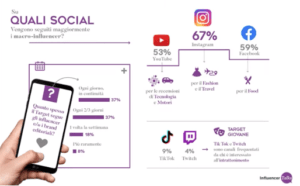
Ci hanno intrattenuti nel periodo più difficile della pandemia, stravolgendo i loro piani editoriali per adattarli alle nuove contingenze. Dopo i virologi, gli influencer sono risultati tra i soggetti che hanno ricevuto più seguito tra gli italiani: ma come sono percepiti? La ricerca “Italiani & Influencer: i protagonisti dei social visti dai loro follower” ha provato a tracciarne uno spaccato.
Oltre 230 tra brand editoriali sui social media e social star italiani – ovvero quanti hanno saputo conquistare la notorietà sui social network raggiungendo oltre 100mila follower – sono i soggetti scelti nell’indagine “Italiani & Influencer” realizzata da Buzzoole, Mondadori Media e InfoValue.
La ricerca ha provato a spiegare la relazione degli italiani con gli influencer e, in particolare, il ruolo che questi svolgono nel processo d’acquisto, contattando oltre 1.500 persone rappresentative di di 12 milioni di italiani nella fascia 18-54 anni, che seguono sui social almeno un macro-influencer o un brand editoriale in una delle 9 aree tematiche indagate (Salute e Wellness, Famiglia e Figli, Intrattenimento, Tech e Scienza, Beauty, Fashion, Food, Travel e Auto e Moto).

Dalla ricerca emerge come Instagram (67%), Facebook (59%) e YouTube (53%) siano i canali preferiti dagli italiani per seguire con continuità brand e macro-influencer, mentre tra i più giovani spiccano due piattaforme nuove, come TikTok e Twitch, legate per lo più all’area Intrattenimento.
Il campione di utenti segue in media più di 3 aree tematiche: le donne sono maggiormente interessate ai settori Beauty, Famiglia e Figli, Fashion e Food; gli uomini prediligono Auto e Moto, Tech e Intrattenimento.
Tra i ruoli principali assolti da brand editoriali e macro-influencer nel processo di acquisto, spicca l’aspetto più “commerciale”: vengono scelti dagli italiani in qualità di “Tutor”, ovvero una fonte autorevole per l’approfondimento di un prodotto (54%) o per la conoscenza di un nuovo servizio (47%). Gli italiani li prediligono per lo più come esperti dai quali ricevere consigli utili su una particolare tematica, oppure come modello nel quale identificarsi. E la considerazione che hanno all’interno del funnel di vendita è molto elevata, come si evince dal grafico riportato.

Ecco alcuni degli influencer ritenuti dagli italiani tra i “Top of Mind” in diversi settori


“L’aspetto critico – ha commentato Gianluca Perrelli, CEO di Buzzoole – è la scelta del giusto influencer. Non tutti gli influencer vanno bene per un contenuto o un settore. Per raggiungere gli obiettivi di marketing bisogna guardare a due dimensioni: da una parte, come l’influencer è percepito dall’audience; dall’altra, ci sono le industrie di appartenenza. Da qui vengono fuori i cluster, ovvero i gruppi di influencer che possono realmente influire nel processo di acquisto. L’influencer agisce sul customer journey con tempistiche diverse rispetto al media. Esistono cicli di conversione non immediati, che possono essere dilatati nel tempo e produrre risultati nel medio periodo. Il cliente parte dal post dell’influencer per fare un acquisto, ma poi bisogna guardare all’ecosistema che c’è intorno. Nel post pandemia abbiamo visto crescere curiosità tra le aziende su come ingaggiare i creators in campagne per fare conversione, spinte anche dalle nuove funzionalità e-commerce di Facebook e Instagram e arrivare a coinvolgere gli influencer per parlare in diretta di un prodotto e fare acquisti tramite App”.
“Non tutti i brand o prodotti – ha proseguito Elisabetta Corazza, Head of Digital Marketing Danone Italia – hanno bisogno di influencer. La scelta dipende dalla leva di marketing da cui è influenzato il target e dall’obiettivo che si vuole raggiungere. Gli influencer sono scelti per la credibilità e l’immagine che hanno presso la loro follower base e per il posizionamento associato al brand e, dunque, al target. Danone non fa l’influencer marketing da sempre, ma ha iniziato a farlo prima che si chiamasse così. Oggi abbiamo un approccio continuativo, le relazioni sono ‘always on’: noi sposiamo l’influencer e viceversa. Rispetto a cinque anni fa, sono cambiati gli investimenti e i player del settore. Le piccole e medie imprese investono budget sempre più consistenti e le aziende si pongono molte domande su chi possano essere i partner giusti. Maggiori sono gli investimenti e più alta è l’aspettativa del ROI”.
“Prima dell’avvento dei social – ha concluso Andrea Santagata, Direttore Generale Mondadori Media – i brand editoriali erano delle guide per consigli e leve aspirazionali. Oggi il brand si mette in secondo pianoe diventa un servizio per la persona che sta guardando il contenuto. Il protagonista è la persona che, ad esempio, la sera a casa deve realizzare una ricetta. Diventiamo l’amico, ci mettiamo alla pari con lei/lui. Con gli influencer siamo in parte in competizione, ma questo ha aperto anche nuovi mercati. Mondadori, ad esempio, sta investendo molto su TikTok e lavora insieme al creator per creare nuovi palinsesti. Su alcuni linguaggi, gli influencer sono arrivati prima e l’effetto è vincente, al punto che oggi collaboriamo con più di 300 professionisti non solo per offrire eventi e soluzioni più avanzate, ma per arricchire i contenuti”.


